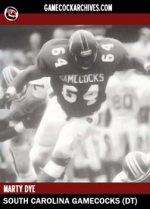Gamecock Fanatics
You are using an out of date browser. It may not display this or other websites correctly.
You should upgrade or use an alternative browser.
You should upgrade or use an alternative browser.
Countdown to Kickoff
- Thread starter Swayin
- Start date
Homebrewcock
GCF Top Poster
USS Enright, APD-66 (formerly DE-216).
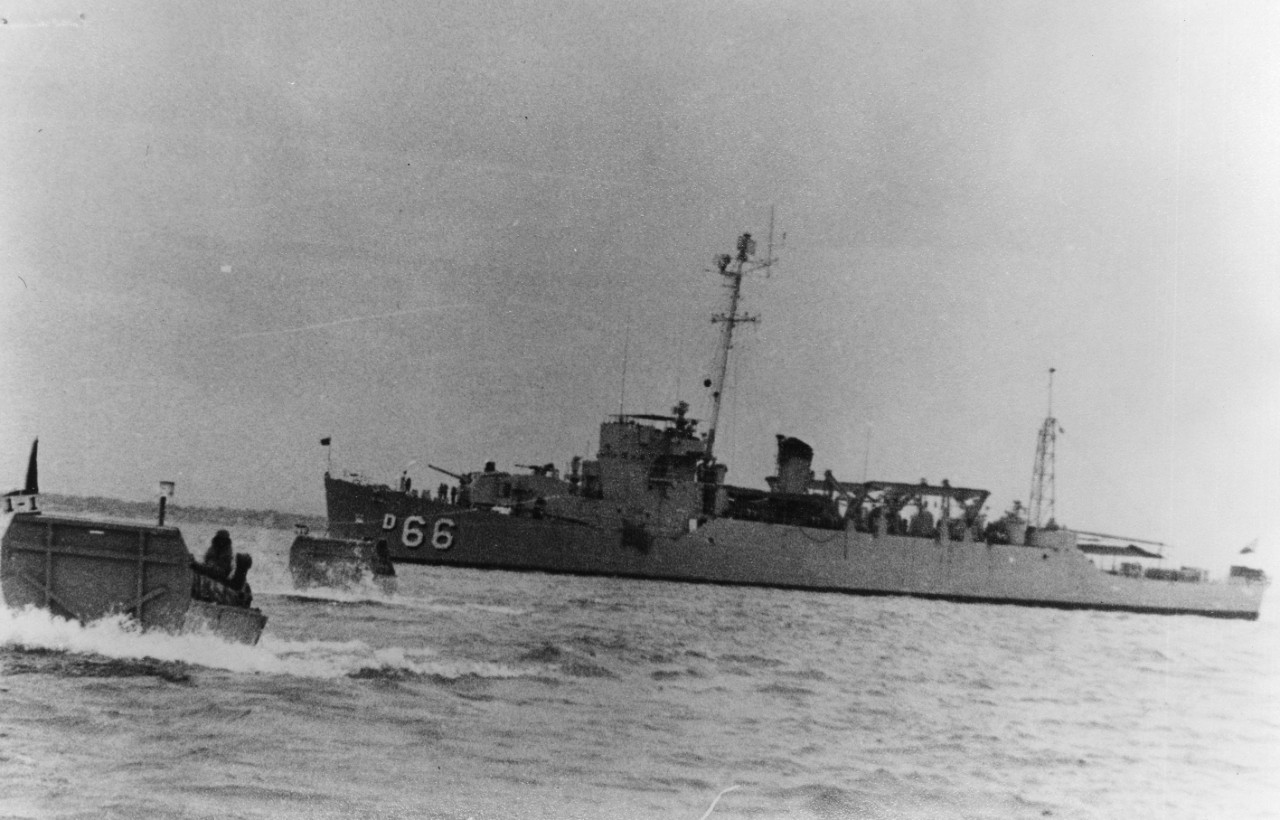
https://www.history.navy.mil/our-collections/photography/numerical-list-of-images/nhhc-series/naval-subjects-collection/l45--us-navy-ships/81-100/l45-84-01-01-uss-enright--apd-66-.html
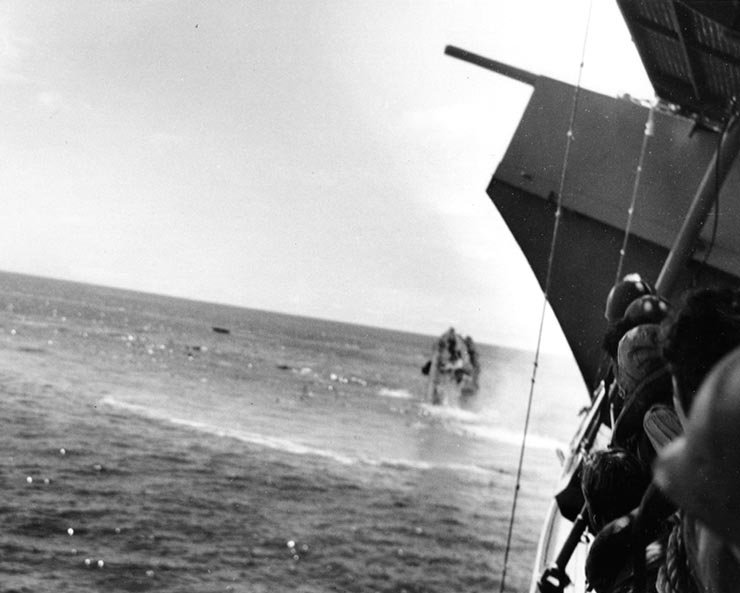
https://en.wikipedia.org/wiki/USS_Hammann_(DD-412)
The Hammann's daring rescue of the two Navy pilots on Guadalcanal was a full 4 months before the invasion of Guadalcanal by American forces on August 7, 1942.
Pretty courageous stuff.

https://www.history.navy.mil/our-collections/photography/numerical-list-of-images/nhhc-series/naval-subjects-collection/l45--us-navy-ships/81-100/l45-84-01-01-uss-enright--apd-66-.html
https://en.wikipedia.org/wiki/USS_Enright_(DE-216)USS Enright (DE-216/APD-66), a Buckley-class destroyer escort of the United States Navy, was named in honor of Ensign Robert Paul Francis Enright (1916-1942), who was killed in action while serving aboard the destroyer Hammann (DD-412) during the Battle of Midway on 6 June 1942.
The destroyer Hamman sinks quickly bow-first (below) after being broken in half by a Japanese torpedo in this photo apparently taken from the Yorktown at the Battle of Midway.USS Hammann (DD-412) was a World War II-era Sims-class destroyer in the service of the United States Navy, named after Ensign Charles Hammann, a Medal of Honor recipient from World War I. Hammann was sunk during the Battle of Midway, trying to assist the sinking aircraft carrier USS Yorktown.
Pacific Duty
The destroyer took part in training maneuvers in the New Caledonia area during early March, and on 27 March the Task Force departed for the Coral Sea. Hammann acted as screening ship and plane guard for Lexington, Returning to Tongatapu on 20 April, the Task Force sortied again into the Coral Sea on 27 April for a surprise air raid on Japanese Invasion forces on Tulagi.
While screening the carriers during the air raids of 4 May, Hammann was directed to rescue two fighter pilots downed on Guadalcanal, some 40 miles (65 km) to the north. Steaming at full speed, the destroyer arrived at dusk and sighted a marker on the beach, which proved to be a parachute. The motor whaleboat was put over the side, but dangerous surf prevented it from landing. Consequently, the pilots were recovered with the use of lines from the boat. This accomplished, an attempt was made to destroy the wreckage of the aircraft, but the rough water made this impossible, and Hammann returned to Lexington's screen from this successful operation that night.
The Battle of the Coral Sea
On 8 May came the main action of the Battle of the Coral Sea, the first naval engagement fought entirely on both sides between aircraft and ships. During the exchange of air attacks, Hammann screened the carriers, firing at Japanese torpedo planes as they attacked. Just as the torpedo planes retired, dive bombers appeared, one exploding a bomb a scant 200 yards (200 m) off Hammann's starboard bow. Lexington, which had taken two devastating torpedo hits to port, was first thought to be under control, but a large internal explosion shortly before 1300, followed later by others, sealed her fate. As the order was given to abandon ship, Hammann, Morris, and Anderson stood by to receive survivors. The destroyer picked up nearly 500 men from the water before "Lady Lex" went down the night of 8 May, torpedoed by Phelps.
The Battle of Midway
The Battle of the Coral Sea, which checked the Japanese advance to the southeast, was over, but new demands called Hammann to the north. Under urgent orders from Admiral Chester Nimitz to meet a new threat, Hammann moved to Pearl Harbor with the Task Force, arriving on 27 May. After making repairs, it got underway on 30 May and was just in time to take part in the Battle of Midway.
During the air battle on 4 June, Hammann screened Yorktown, helping to shoot down many of the attacking aircraft. However, the carrier took two torpedo hits and, listing heavily, was abandoned that afternoon. Hammann picked up survivors in the water, including Yorktown's skipper, Captain Buckmaster, and transferred them to the larger ships. Efforts were mounted to save the stricken carrier on the next morning. A skeleton crew returned on board the Yorktown, and attempts were made to tow her to safety. Hammann came alongside on 6 June to transfer a damage control party. The destroyer then lay alongside, providing hoses and water for firefighting, power, and other services while tied up next to the carrier.
The salvage party was making progress when the protective destroyer screen was penetrated by Japanese submarine I-168 after noon on 6 June. Four torpedoes were fired; one missed, two passed under Hammann and hit Yorktown, and the fourth hit the destroyer amidships, breaking her in half.
As the debris from the explosion rained down and the ships lurched apart, it was apparent that the Hammann was doomed. Life rafts were lowered and rescue efforts by surrounding ships commenced. The Hammann sank, bow first, in just four minutes. During that time, Chief Machinist Mate Daniel William Carlson was able to launch a life raft, pass out life vests, and help others over the side of the ship to safety. Following the sinking there was a violent underwater explosion, the likely cause of which was the destroyer's depth charges and torpedoes. The explosion caused many deaths in the water, bringing the death toll to 80. Survivors were taken aboard the destroyers Benham and Balch.

https://en.wikipedia.org/wiki/USS_Hammann_(DD-412)
The Hammann's daring rescue of the two Navy pilots on Guadalcanal was a full 4 months before the invasion of Guadalcanal by American forces on August 7, 1942.
Pretty courageous stuff.
Last edited by a moderator:
USS Wake Island, CVE-65.
_underway_on_5_January_1945_(80-G-301306).jpg/1280px-USS_Wake_Island_(CVE-65)_underway_on_5_January_1945_(80-G-301306).jpg)
_underway_on_5_January_1945_(80-G-301306).jpg/1280px-USS_Wake_Island_(CVE-65)_underway_on_5_January_1945_(80-G-301306).jpg)
https://en.wikipedia.org/wiki/USS_Wake_IslandOn 16 February, after loading supplies and embarking Army and Navy officers for transportation, Wake Island set course for Recife, Brazil, the first stop on her voyage to Karachi, India. She arrived at Recife on 1 March and made stops at Cape Town, South Africa, and Diego Suarez Harbor, Madagascar, before arriving at Karachi on 29 March. The carrier began her return trip on 3 April and arrived back at Norfolk on 12 May.
She spent the remainder of May and part of June undergoing alterations and an overhaul. She then took on board the planes and personnel of VC-58 and, on 15 June, set course toward Bermuda for duty as the nucleus of Task Group 22.6 (TG 22.6), a combined, air-and-surface, anti-submarine, hunter-killer group. The highlight of her cruise came on 2 July, when one of her Grumman TBM Avengers intercepted the German submarine U-543 off the coast of Africa between the Canary and Cape Verde Islands, making its way home after an unsuccessful patrol in the Gulf of Guinea. The pilot, Ensign Frederick L. Moore, braved heavy anti-aircraft fire from U-543, while making two bombing attacks which sank the U-boat. However, no evidence appeared to confirm the kill, so the carrier and her escorts spent the next two weeks hunting the already-destroyed submarine.
USS Enterprise, CVN-65.
_underway_in_the_Atlantic_Ocean_on_14_June_2004_(040614-N-0119G-020).jpg/1280px-USS_Enterprise_(CVN-65)_underway_in_the_Atlantic_Ocean_on_14_June_2004_(040614-N-0119G-020).jpg)
May you live long and prosper, Big E.
_underway_in_the_Atlantic_Ocean_on_14_June_2004_(040614-N-0119G-020).jpg/1280px-USS_Enterprise_(CVN-65)_underway_in_the_Atlantic_Ocean_on_14_June_2004_(040614-N-0119G-020).jpg)
https://en.wikipedia.org/wiki/USS_Enterprise_(CVN-65)The only ship of her class, Enterprise was, at the time of inactivation, the third-oldest commissioned vessel in the United States Navy after the wooden-hulled USS Constitution and USS Pueblo. She was inactivated on 1 December 2012, and officially decommissioned on 3 February 2017, after over 55 years of service. She was stricken from the Naval Vessel Register the same day.
The name has been adopted by the future Gerald R. Ford-class aircraft carrier USS Enterprise (CVN-80).
May you live long and prosper, Big E.
Last edited by a moderator:
USS Benfold, DDG-65.
_underway_in_South_Pacific_010326-N-1644C-001.jpg/1280px-Port_bow_view_of_USS_Benfold_(DDG-65)_underway_in_South_Pacific_010326-N-1644C-001.jpg)

https://en.wikipedia.org/wiki/Edward_Clyde_Benfold
_underway_in_South_Pacific_010326-N-1644C-001.jpg/1280px-Port_bow_view_of_USS_Benfold_(DDG-65)_underway_in_South_Pacific_010326-N-1644C-001.jpg)
https://en.wikipedia.org/wiki/USS_BenfoldNamed for posthumous Korean War United States Marine Corps Medal of Honor recipient Hospital Corpsman Third Class Edward Clyde Benfold, she joined the U.S. Pacific Fleet for service on 30 March 1996.
Early life and education
Benfold was born in Staten Island, the son of Edward and Glenys Benfold. His father served as a Merchant Marine Officer (1st engineer) during World War II and was killed in action serving on the Honduran ship Castilla on June 7, 1942 when the ship was torpedoed and sunk by the German submarine U-107 near Cuba.
Benfold grew up in Haddon Heights, New Jersey, and lived in nearby Audubon, where he graduated from Audubon High School in 1949.
Medal of Honor
Benfold was awarded the Medal of Honor posthumously. On July 16, 1953, The medal was presented by Rear Admiral John H. Brown Jr., Commandant of the 4th Naval District, to his one-year-old son, Edward Joseph, who was his next of kin (NOK) as his wife remarried.
CITATION:
For gallantry and intrepidity at the risk of his life above and beyond the call of duty while serving as a Hospital Corpsman, attached to a company in the First Marine Division during operations against enemy aggressor forces in Korea on September 5, 1952. When his company was subjected to heavy artillery and mortar barrages, followed by a determined assault during the hours of darkness by an enemy force estimated at battalion strength, HC3c. BENFOLD resolutely moved from position to position in the face of intense hostile fire, treating the wounded and lending words of encouragement. Leaving the protection of his sheltered position to treat the wounded when the platoon area in which he was working was attacked from both the front and the rear, he moved forward to an exposed ridge line where he observed two Marines in a large crater. As he approached the two men to determine their condition, an enemy soldier threw two grenades into the crater while two other enemy charged the position. Picking up a grenade in each hand, HC3c. BENFOLD leaped out of the crater and hurled himself against the onrushing hostile soldiers, pushing the grenades against their chests and killing both the attackers. Mortally wounded while carrying out this heroic act, HC3c. BENFOLD, by his great personal valor and resolute spirit of self-sacrifice in the face of almost certain death, was directly responsible for saving the lives of his two comrades. His exceptional courage reflects the highest credit upon himself and enhances the finest traditions of the United States Naval Service. He gallantly gave his life for others.
Harry S. Truman

https://en.wikipedia.org/wiki/Edward_Clyde_Benfold
USS Chosin, CG-65.
_returns_to_sea_following_a_yard_period.jpg/1280px-USS_Chosin_(CG_65)_returns_to_sea_following_a_yard_period.jpg)
_returns_to_sea_following_a_yard_period.jpg/1280px-USS_Chosin_(CG_65)_returns_to_sea_following_a_yard_period.jpg)
https://en.wikipedia.org/wiki/USS_ChosinUSS Chosin (CG-65) is a Ticonderoga-class guided-missile cruiser serving in the United States Navy. She is named in honor of the Battle of Chosin Reservoir of the Korean War.
Last edited by a moderator:
USS Burke, APD-65. Formerly DE-215.
.jpg)
.jpg)
https://en.wikipedia.org/wiki/USS_Burke_(DE-215)USS Burke (DE-215/APD-65), a Buckley-class destroyer escort of the United States Navy, was named in honor of Lieutenant Commander John E. Burke (1905–1942), who was killed in action, aboard the battleship South Dakota during the Naval Battle of Guadalcanal on 15 November 1942.
https://en.wikipedia.org/wiki/USS_South_Dakota_(BB-57)Second Naval Battle of Guadalcanal
Having inadvertently closed to within 5,000 yd (4,600 m) of Kondō's force, South Dakota bore the brunt of Japanese attacks during this phase of the battle. Japanese destroyers illuminated the ship and the rest of Kondō's vessels concentrated their fire on South Dakota. She received 27 hits during this phase, including a 14-inch shell from Kirishima that hit the rear turret and failed to penetrate the armor, though it damaged the training gear. Most of the hits came from the medium-caliber guns of the cruisers and destroyers, though they were largely confined to the superstructure, where they did not threaten the ship's survival. They nevertheless inflicted significant damage, destroying radar sets, disabling radio systems, and knocking out other systems, leaving the ship in Lee's words "deaf, dumb, blind, and impotent."
Focused on South Dakota, the Japanese left Washington unengaged, allowing her to attack Kirishima without any disruption. South Dakota fired two or three salvos at the next Japanese ship in the line before shifting fire to target Kirishima as well, firing five salvos in total before checking her fire as her gun directing equipment had been disabled; her secondary battery nevertheless kept up a heavy fire. Washington quickly inflicted fatal damage on Kirishima, destroying two of her four main battery turrets, holing her below the waterline, and starting numerous fires. Shortly after midnight, Kondō turned his ships to bring them back into torpedo range, leaving the stricken Kirishima to steam out of control. At 00:05, the Japanese ceased firing at South Dakota and she increased speed to 27 knots (50 km/h; 31 mph) and checked her fire at 00:08. Since her radios had been disabled by gunfire, Gatch could not communicate with Lee, so he turned south and disengaged.
A hit below the waterline caused minor flooding and a list of 0.75 degrees, though that was quickly corrected. Fires that shell hits had started were suppressed by 01:55. At around 02:00, South Dakota restored radio contact with Washington and Gatch informed Lee of his ship's condition. Lee ordered Gatch to withdraw at high speed. South Dakota's crew had suffered heavy casualties, with 40 killed and 180 wounded. Among the injured was 12-year old Calvin Graham, who had lied about his age to enlist; he was the youngest American to fight in the war. South Dakota received the Navy Unit Commendation for her role in the battle.
Last edited by a moderator:
USS Lee Fox, DE-65.
Built with dispatch, Lee Fox helped to overcome the German submarine menace in the Atlantic. Her greatest enemy, however, turned out to be the buffeting storms of the North Atlantic. Returning from her Bermuda shakedown voyage on 17 October 1943, she was overtaken by a hurricane that almost capsized the vessel and caused a fire in the aft engine room. On 11 December off Cape Cod, during a storm, a projectile exploded on her forecastle, causing more fire damage and further yard repairs.
Overcoming her early misfortunes, Lee Fox completed 18 Atlantic crossings between 6 November 1943 and 7 January 1945. Derry, Northern Ireland, became her port away from home as she helped escort the invasion troops and supplies to England for "Operation Overlord", the invasion of Normandy. The last round-trip voyage required 30 days to convoy heavy equipment, such as floating cranes and powerplants, being towed to Plymouth, England, for use in the captured ports on the continent. Her only sure contact with enemy submarines occurred on 20 December 1944 when two ships in the return convoy were torpedoed.
Beginning on 21 February 1945, Lee Fox was converted to a Charles Lawrence-class high speed transport and reclassified APD-45 two days later. On 7 May, she sortied from Norfolk, Virginia, with TU 29.6.1 bound for the war in the Pacific. Lee Fox arrived at Pearl Harbor on 31 May, having transited the Panama Canal on 13 May and spent three days at San Diego, California.
After she had additional training with Naval Combat Demolition Teams, 120 passengers were embarked on 18 June for Guam. Continuing westward from Guam with a new list of passengers, Lee Fox next dropped anchor in San Pedro Bay, Philippines, on 6 July. Here, the end of the war overtook her, but on 9 September the first of a series of escort assignments ended at Tokyo Bay. As a member of TU 53.7.1, she sailed for Yokohama on 23 October to see that the northern Japanese islands of Ōshima and others nearby were complying with the terms of surrender.
Released from this duty on 15 November, she sailed for home before the end of the month and disembarked 123 veterans at San Diego on 15 December. Departing New Year's Day 1946, she reached her home port of Boston on 17 January. Following a period in dry dock, she arrived at Green Cove Springs, Florida, on 14 February 1946 and decommissioned there on 13 May and entered the Atlantic Reserve Fleet.
Struck from the Navy List on 1 September 1964, Lee Fox was sold on 31 January 1966 for scrapping to the Southern Scrap Material Company, New Orleans, Louisiana.
_off_New_York_City_on_13_October_1944.jpg)
Built with dispatch, Lee Fox helped to overcome the German submarine menace in the Atlantic. Her greatest enemy, however, turned out to be the buffeting storms of the North Atlantic. Returning from her Bermuda shakedown voyage on 17 October 1943, she was overtaken by a hurricane that almost capsized the vessel and caused a fire in the aft engine room. On 11 December off Cape Cod, during a storm, a projectile exploded on her forecastle, causing more fire damage and further yard repairs.
Overcoming her early misfortunes, Lee Fox completed 18 Atlantic crossings between 6 November 1943 and 7 January 1945. Derry, Northern Ireland, became her port away from home as she helped escort the invasion troops and supplies to England for "Operation Overlord", the invasion of Normandy. The last round-trip voyage required 30 days to convoy heavy equipment, such as floating cranes and powerplants, being towed to Plymouth, England, for use in the captured ports on the continent. Her only sure contact with enemy submarines occurred on 20 December 1944 when two ships in the return convoy were torpedoed.
Beginning on 21 February 1945, Lee Fox was converted to a Charles Lawrence-class high speed transport and reclassified APD-45 two days later. On 7 May, she sortied from Norfolk, Virginia, with TU 29.6.1 bound for the war in the Pacific. Lee Fox arrived at Pearl Harbor on 31 May, having transited the Panama Canal on 13 May and spent three days at San Diego, California.
After she had additional training with Naval Combat Demolition Teams, 120 passengers were embarked on 18 June for Guam. Continuing westward from Guam with a new list of passengers, Lee Fox next dropped anchor in San Pedro Bay, Philippines, on 6 July. Here, the end of the war overtook her, but on 9 September the first of a series of escort assignments ended at Tokyo Bay. As a member of TU 53.7.1, she sailed for Yokohama on 23 October to see that the northern Japanese islands of Ōshima and others nearby were complying with the terms of surrender.
Released from this duty on 15 November, she sailed for home before the end of the month and disembarked 123 veterans at San Diego on 15 December. Departing New Year's Day 1946, she reached her home port of Boston on 17 January. Following a period in dry dock, she arrived at Green Cove Springs, Florida, on 14 February 1946 and decommissioned there on 13 May and entered the Atlantic Reserve Fleet.
Struck from the Navy List on 1 September 1964, Lee Fox was sold on 31 January 1966 for scrapping to the Southern Scrap Material Company, New Orleans, Louisiana.
_off_New_York_City_on_13_October_1944.jpg)
Homebrewcock
GCF Top Poster
Homebrewcock
GCF Top Poster
USS Vincennes, CL-64.
_underway_in_San_Francisco_Bay_on_29_August_1945_(NH_98189).jpg)
_underway_in_San_Francisco_Bay_on_29_August_1945_(NH_98189).jpg)
https://en.wikipedia.org/wiki/USS_Vincennes_(CL-64)Leyte Gulf
Vincennes then operated in the vicinity of Visayas, in the Philippines, screening, as before, the fast carriers. Enemy snoopers closed the formation on several occasions; detected early on the 24th, a Japanese four-engine flying boat — a Kawanishi H8K "Emily" — went down in flames to the guns of friendly fighters.
Meanwhile, the Battle for Leyte Gulf was shaping up. At 03:25 on the 24th, Vincennes received reports of the presence of an enemy force. Four battleships, eight heavy cruisers, and 13 destroyers had been detected 7 mi (6.1 nmi; 11 km) south of Buruncan Point, Mindanao Island. Enemy planes commenced a determined air attack; all ships in Vincennes' group maneuvered radically to avoid possible torpedoes.
At 02:30 on the 25th, two enemy task groups were reported about 85 mi (74 nmi; 137 km) north of Vincennes' formation. At 03:00, the light cruiser and her consorts headed north to engage; at 07:33, an intercepted report from a search plane told of many enemy surface ships about 120 mi (100 nmi; 190 km) north and headed south at 20 kn (23 mph; 37 km/h). Aircraft from the fast carriers launched and took off on the hunt, conducting persistent strikes on the Japanese ships that resulted in heavy enemy losses.
Vincennes subsequently headed south toward the San Bernardino Strait in anticipation of making contact with the enemy ships, including stragglers, that were expected to transit the strait in retiring from the day's operations.
At 00:26, Vincennes' radar plot disclosed a surface contact at a distance of 21,000 yd (19,000 m). Vincennes, Miami, and Biloxi, escorted by DesDiv 103, broke from the formation to attack. At 00:54, gun-flashes from Vincennes and her sisters' main battery split the night; both main and secondary batteries — 6 and 5-inch guns — in company with the 5-inch guns of the destroyers, hurled salvoes at the enemy vessel. The vessel — tentatively identified as a cruiser — sank beneath the waves at 01:49 as a result of the deluge of rapid shellfire. Their victim was actually the Nowaki.




:format(jpeg)/cdn.vox-cdn.com/uploads/chorus_image/image/46660534/1D4_9509_jpg_900x600_q85.0.0.jpg)

_underway_off_Boston_on_21_July_1944_(80-G-237944).jpg)
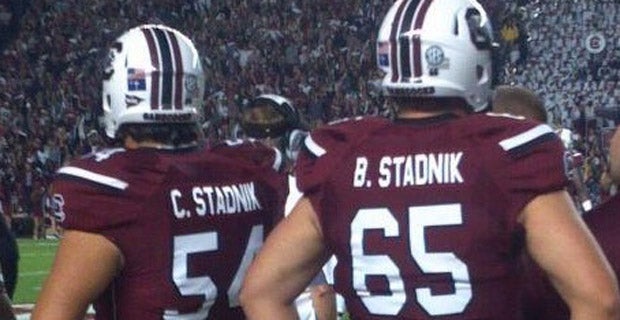

_underway_at_sea,_circa_1988-1991_(NH_97206-KN).jpg/800px-USS_Wisconsin_(BB-64)_underway_at_sea,_circa_1988-1991_(NH_97206-KN).jpg)
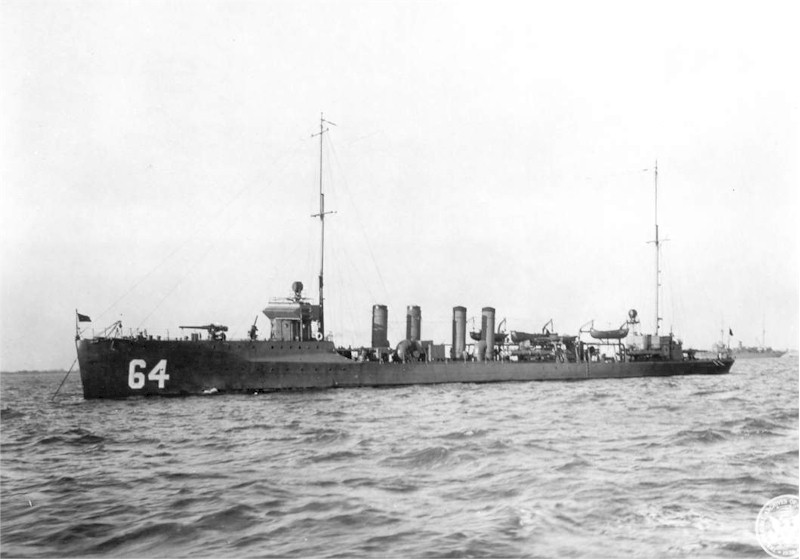
_returns_to_its_homeport_in_San_Diego.jpg/1920px-US_Navy_030602-N-8590B-001_USS_Constellation_(CV_64)_returns_to_its_homeport_in_San_Diego.jpg)
.jpg/1920px-USS_Gettsyburg_(CG-64).jpg)
